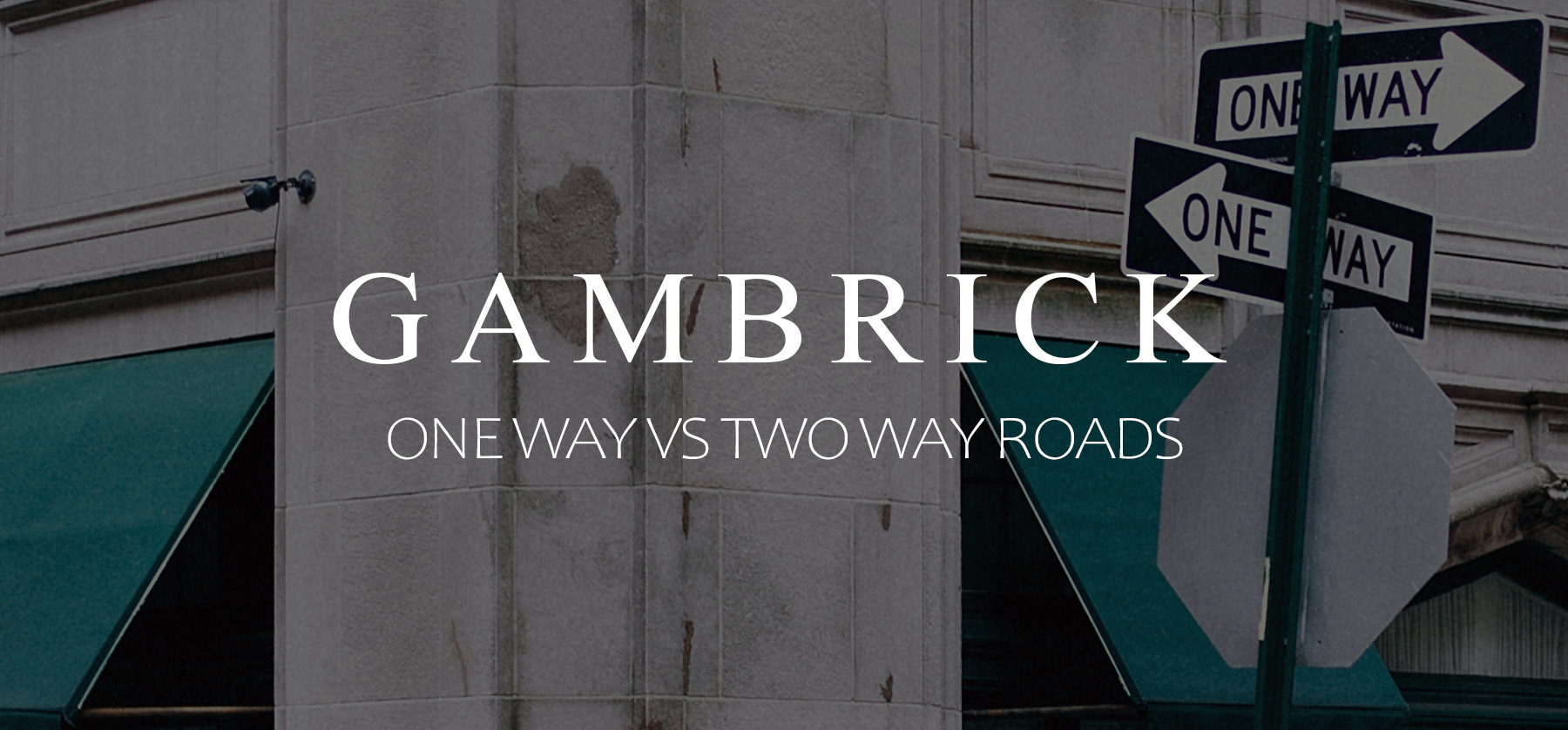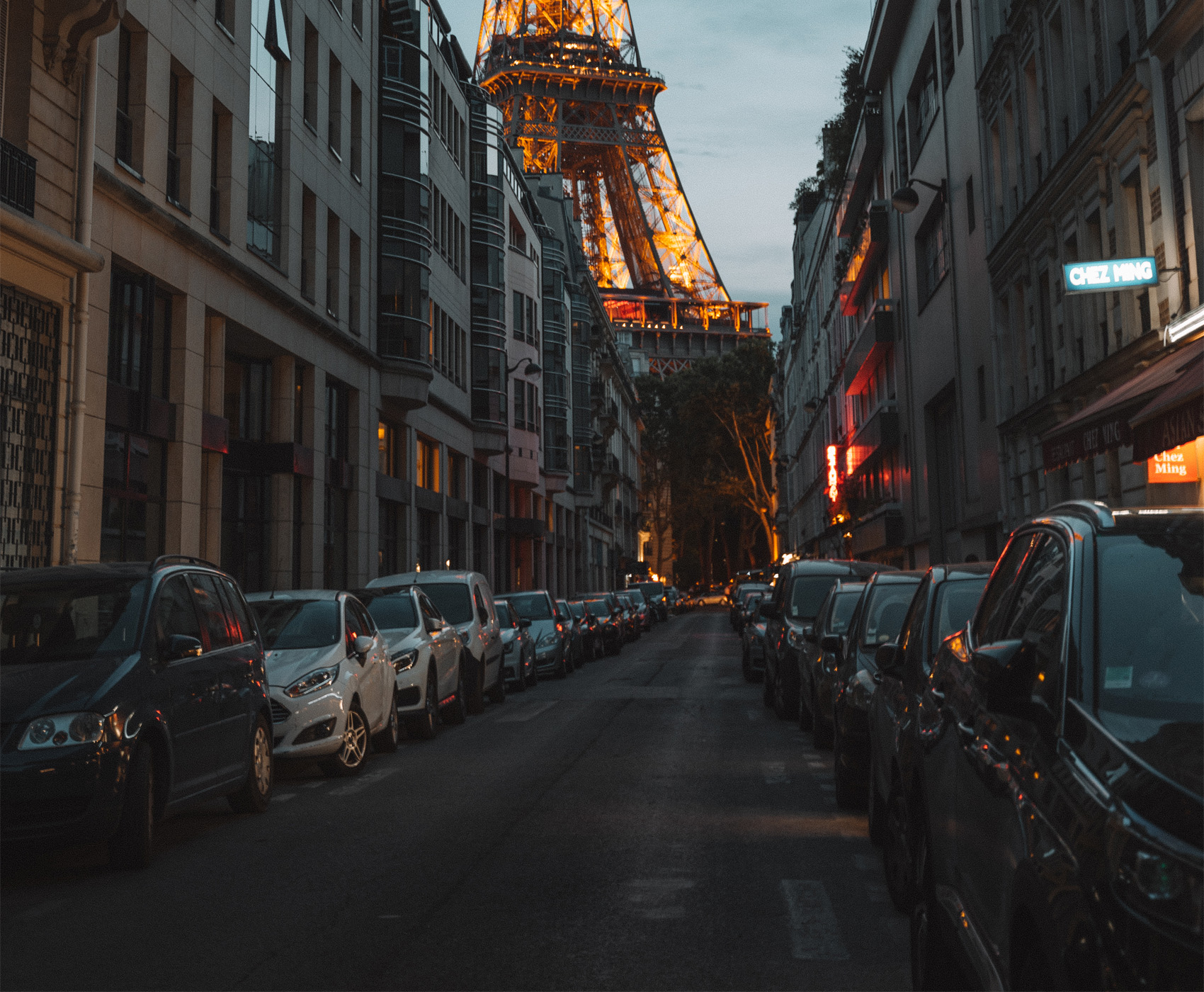One Way Vs Two Way Roads
If it’s your first time driving in an area with one way streets, it can be confusing to know which roads you can safely turn down. This is very common in cities that have both one way and two way streets that often intersect. It’s important to understand the difference between one way vs two way roads, and how to tell them apart, so you don’t drive in the wrong direction.
A one-way street only allows vehicles to travel in a single direction. No vehicles are allowed to travel in the opposite direction of the traffic flow. There are usually indications on the road and signs to let you know the street is a one way. On a two way road, vehicles can travel in both directions. There generally aren’t signs or indications of two way streets because they’re the standard.
If your in a new city or town and aren’t sure about the roads, there are some things you can look for to help you figure out which are one way vs two way. Most one way roads will have either arrows painted on the road or a one way road sign. However, if you’re turning onto a road, look for no-turn signs. The reason there’s a no turn sign is usually because it’s a one way street.
Another sign of a one way street is the size of the road. Narrow streets are usually a one way because they’re not wide enough for two cars.
A sign I look for when driving in cities is the direction the parked cars are facing. If they’re facing the same direction on both sides of the street, it’s a one way road. However, if they’re facing in opposite directions, it’s a two way street.
What’s The Difference Between One Way Vs Two Way Streets?
A one-way street means that traffic is only allowed to flow in one direction while a two way street allows traffic to flow in opposite directions. One way vs two way roads refers to the flow of traffic, not the number of lanes in the road. For example, a one way street could be a single small lane or a 4 lane road. Manhattan is an example of a city that has both multi-lane and single lane one way streets.
Look out for road signs, traffic signals, road arrows, warning signs, traffic lights and parked cars to determine if a road is one way or two.
Many cities have roads called a dual carriageway, or a divided highway, which is a roadway with two carriageways (roads in each direction) that are physically divided by a center bit of land. Each side of the carriageway is a one way street and may have multiple lanes. Many carriageways have trees or buildings in the center area between roadways.
- A divided carriageway is a pair of one way streets separated by a bit of land in the middle. The median area can be filled with grass, tress, buildings, shops, a gas station, etc. This is a very common street design in cities and large highways.
When driving in an unfamiliar area, always watch out for signs and signals that indicate where one way roads are. They’re very common in cities and urban areas. Pay extra attention at intersections to avoid turning down a one way street facing the wrong direction.
How To Determine If A Street Is One Way Vs Two Way
When driving in an unfamiliar area, it’s very important to know to distinguish between a one way and a two way street. This can be especially important in tight urban areas and cities with narrow streets and lots of small one way roads.
Here are some ways to tell which roads are one way and which are not:
1. Street Signs
One of the best ways to determine if a road is a one way vs a two way street, is to look for signs. Most one way streets will have a sign at every intersection that says “One Way”, with an arrow pointing in the direction you can travel with your vehicle.
- One Way street signs are easy to spot, they’re typically white with a black arrow pointing in the direction of travel and say “One Way”.
- You should also look out for Do Not Enter signs because they usually mean “the One Way Starts here”.
- Also look out for signs prohibiting turns, such as “No Right Turn” or “No Left Turn.”. They typically signify a one way street.
- Watch out for arrows with a no symbol in front of them, it looks like a circle with a diagonal line running through it. They mean do not turn in the direction the arrow is pointing.
If you’re driving in an unfamiliar area, pay close attention to road signs and traffic signals. They’ll indicate the one way roads and the direction you should, and shouldn’t, drive.
2. Parked Cars
By looking at parked cars, you can determine the direction of travel for the road. Cars always park in the same direction as the flow of traffic. If parked cars on both sides of the street are facing the same direction, it’s a one way street. If cars parked on the sides of the road are facing opposite directions, it’s a two way street.
- Cars parked on the side of the road face the same direction as the flow of traffic.
- When parked cars on both sides of the street face the same direction, the road is a one way.
- If parked cars on the side of the road face opposite direction, the road is a two way.
- If there are no parked cars, look for street signs and other signals.
Looking at the direction cars are parked is a good way to quickly determine if a street is a one way vs a two way in most cities. However it’s not always accurate because some cities only allow parking on one side of the street. So look for other indicators too like street signs, signals and arrows on the road.
3. Road Arrows
Many areas will paint white arrows on the road to indicate the direction of travel for the road. If arrows on both sides of the road face the same direction, it’s a one way street. If there’s an arrow on one side of the road but not the other, it’s likely a two way street.
Arrows are most common at intersections when turning from one street to another. They help guide drivers into the correct lane. If you’re driving on unfamiliar roads, watch out for arrows to show you the direction you should and shouldn’t drive.
- White arrows painted on the road will indicate the direction of travel.
- Arrows are most common at intersection to help guide drivers when turning onto a new road.
- Following the direction of arrows will help you drive in the correct direction and lane.
When in doubt, follow the arrows. They’ll tell you the direction you can and can’t drive as well as helping you stay in the correct lane at intersections.
4. Street Line Color
Roads at least 2 lanes wide generally have lines painted on them to separate the lanes. They’re either solid or dashed and painted either white or yellow. The reason street lines are different colors is to help indicate the direction of travel for the road. The reason they’re solid vs dashed indicates whether passing is allowed or not.
- Drivers should always stay to the right of yellow lines. A solid yellow line indicates that passing is prohibited while a dashed yellow line indicates that passing is allowed.In general, two way roads have yellow lines.
- White lines separate lanes for which travel is in the same direction. A double white line indicates that lane changes are prohibited. One way roads typically have white lines.
Keep in mind that white lines may indicate that the road is a one way. However they don’t tell you the direction of travel. If you see a road with white lines, look for other indicators like road signs, traffic signals or arrows that will indicate the direction of travel for the street.
- If a street only has white lines on either side, it generally means the street is a one way.
- White lines do not indicate the direction of travel for the one way street.
- Look for other signs, traffic signals or arrows to determine the direction of travel for the one way.
Street line color is another indicator that a road may be a one way vs a two way street. However, I never rely solely on line color when driving in an unfamiliar town or city.
5. The Direction Of Traffic Signals
You can determine if a road is one way vs two by by inspecting the direction of the traffic signals. Glance down a street before driving down it, if you only see the backs or fronts of traffic lights, it’s a one way street. If you see the backs and the fronts of lights, it’s a two way street. The front of a traffic light always faces against, or at, the flow of traffic so drivers can see them.
If you see only the backs of the lights, it’s a one way street and traffic is flowing at you. Do not turn down a road like this because you’ll be driving into head on traffic.
If you see only the front of traffic lights, it’s a one way street that’s flowing away from you. It’s safe to turn down these roads.
- If you only see the back of traffic signal lights, the street is one way and that traffic flow is going towards you. Don’t turn down a road like this or you’ll be facing head on traffic.
- If you see only the front of traffic signal lights, it means the road is a one way with traffic flowing away from you.
- If you see both the front and back of traffic lights, the road is a two way.
Inspecting the direction traffic signals are facing can be a big help in city driving that has lots of intersections. If you find yourself at an unfamiliar intersection, glance down the adjacent road and see what direction the traffic signals are facing before making the turn.
6. Traffic Control Signals
In many cities, clear traffic control signs and signals are poster to let drivers know which direction the roads are traveling, where one way roads are and where you can and can’t drive. They’re typically posted in very visible areas and are easy to see, but they’re also easy to miss if you’re not watching for them.
As you drive on an unfamiliar roadway, especially in a city, watch out for control signs that are there to direct the flow of traffic.
- If you see the front of a traffic control signal, it means you’re traveling in the right direction. Simply follow the sign and let it direct you to the next point along the road.
- Look out for signs that say “One Way”, “Do Not Enter”, or some other type of “Warning”. These signs will tell you the type of street it is or where you can and can’t drive.
- A “Do Not Enter” sign does not necessarily mean the road is a one way. You may simply not be allowed to enter the roadway from where the sign is posted. In some cities, these signs are used to divert and reduce traffic flows.
- Remember that normal two way roads will not have a sign posted. Typically, it’s safe to assume a road is two way unless you see a sign, signal, arrow, warning or other indication that it’s a one way street.
Always pay attention to traffic control signs to make sure you don’t accidentally turn down a one way street. They’re there to help traffic flow in the right direction which prevents accidents.
7. Street Maps
Most street maps and GPS apps will tell you where the one way vs two way roads are. Before driving into an unfamiliar city, I always check a map or my GPS beforehand to familiarize myself with where the one way streets are. They’re always the most confusing to drive on and the most hazardous if you make a wrong turn.
Look for arrows on the map which designate a one-way street and the direction of travel. No arrows means it’s typically a standard two way street.
- Even if you review a map or follow a GPS, don’t turn down a street without looking at road signs, traffic signals, arrows and warnings. Maps and GPS devices may be wrong or the roads may have changed.
- Always follow road signs and traffic signals when determining if a street is one way or two.
As a general rule when reading a city street map, roads are two way unless stated otherwise. One way streets will usually have an arrow with indicates the road is a one way and the direction of travel.
What Is A One-Way Street Traffic Sign?
A one way road sign is a regulatory traffic sign that indicates a one way road. They’re colored white and black with an arrow that points in the direction the traffic is flowing.
- One way street signs direct traffic flow in a single direction.
- They warn drivers not to make any turns onto a one way street in the wrong direction.
- Drivers traveling in the wrong direction of a one way sign will be driving into oncoming traffic.
Watch out for one way signs and never drive in the opposite direction of the arrow.
One Way City Street Tips
Here are a few tips to help you navigate around a city with tight one way streets.
- Cities which contain lots of one way streets are usually designed so that the one way streets alternate. For example, if you cross an North-South one way street that’s going North, the next street will typically be going South. Knowing this makes navigating around a city easier to do because you can anticipate which direction the next one way street will be flowing.
- One way city streets are typically narrow and have cars parked on both sides facing the same direction. If you see a street light this, don’t drive in the direction the cars are facing.
What’s The Purpose Of One Way Streets?
Most one way streets were built in older cities and urban areas when roads were much smaller. They didn’t have cars, trucks and large vehicles like we have today so the city streets were much narrower. Now that cities have grown larger, along with vehicle sizes, the roads are way too small for 2 way traffic. So cities use narrow roads as one way streets which feed into larger two way roads and highways.
However, modern one way streets are very different. These are typically considered divided carriageways which are larger one way streets divided by a center median. Most modern cities and highways follow this design. The median may contain grass and trees or buildings, stores, shops, houses and gas stations.
Because carriageways are large roads with all lanes flowing in the same direction, they’re generally safer with a higher speed limit.
- Older one way roads are typically too narrow to accommodate two-way traffic.
- A two-lane, two-way road is called an urban or arterial road. It has a peak-hour capacity of 1,500 passenger car units (PCU). But a two-lane one-way road has a capacity of 2,400 PCU.Because the lanes are all flowing in the same direction, the road is safer to drive and has a higher speed limit.
- More traffic can be accommodated on a one-way road if there’s a parallel road to handle the opposing traffic flow.
- Lessen signal timing.
- Reduce pedestrian accidents.
A Passenger Car Unit (PCU) is used in Transportation Planning to assess the various vehicle types within a traffic flow group. They help planners determine how many total vehicles a roadway can handle.
Typical factors include: 1 for a car, 1.5 for light commercial vehicles, 3 for trucks and buses, 4.5 for multi-axle vehicles, and 0.5 for motorcycles.
Most Highways Are One Way Roads
Most highways are multi lane one way roads separated by a median. The median may contain things like grass, trees, houses, stores, buildings, service stations or a combination of things. In areas with light traffic, the highway may be a single lane. Or it could have multiple lanes in areas of heavy traffic. But those lanes will all be running in a single direction and separated by white lines.
One way highways separated by a median are called a carriageway. They’re the standard way most large highways are built.
The largest benefit to building one way highways is that they’re safer. Because all the cars are going in the same direction, there are less accidents which means the speed limit can be higher.
Two Way Road Vs One Way Highway
Two way roads are the best design for small local roads with one lane going in opposite directions. The speed limit is typically much lower because you’re driving against oncoming vehicles and separated by just a yellow line.
When highways get bigger, it’s safer to use one way roads separated by a median. Because all the lanes of the highway are flowing in the same direction, travel is safer and speeds can be higher.
The center median which separates a one way highway may contain grass, trees, buildings or a service station. To exit a one way highway and go in the opposite direction, you need to exit the highway and get back on or take a round-about.
Here are some of the benefits of one way highways:
- Better for large traffic flows
- Higher speed limits
- Safer to travel
- Less accidents
- No traffic lights or stop signs
Here are some of the benefits of two way roads:
- Better for local roads with less traffic
- Easier to turn off and on the roadway
- Better for local stores and shopping
- Two way local roads are less confusing to drive on
- Easier to change directions
Both two way roads and one way highways have advantages and disadvantages. They should be used together to manage traffic flows in a safe and effective way.
What Is A Two Way Road?
A two way road is a street that allows vehicles to travel in both directions. On most two way streets, a line is painted down the middle of the road or in between lanes to help keep drivers in their own lane. The color of the lines may be white or yellow and the design could be solid or dashed.
- Yellow: Drivers must always stay to the right side of a yellow line. Typically, you only find yellow lines in the middle of two way streets.
- White: Drivers may cross over a white line.
- Solid: Drivers may not cross over a solid line to change lanes or pass.
- Dashed: Drivers may cross over a dashed line.
Road lines are designed to aid the flow of traffic and prevent accidents. Drivers must always stay to the right side of a yellow. Typically they’re found in the middle of two way street dividing the flow of traffic. However they may be used on some one way streets as well.
White lines can be crossed over and are used on both one way and two way roads.
Why Not Make All Roads 2 Way Streets?
There are a few reasons why not all roads are made 2 way streets. In most old cities, the original roads the city was built around were small and narrow. They weren’t designed for large modern vehicles so there isn’t enough width for a 2 way road. In order to make older one way roads into two way streets, you’d have to rebuild much of the city.
Many modern highways are built as a carriageway. Which are one way streets running in opposite directions with a median in between. Most cities and highways are built with this design. They’re actually safer than 2 way roads because all the cars are driving in the same direction.
- Many one way roads are built to aid the flow of traffic or to make highways safer and faster.
- Others may be one way because converting them to two way streets would be very expensive and could impede the flow of traffic.
- Older cities typically have narrow one way roads because at the time the city was built, there were no cars and/or trucks.
Many one way roads may be wide enough for two vehicles, but there could be traffic conflicts that will impede the smooth flow of straight and turning vehicles if they’re turned into two way streets. Depending on how city planners want to direct the flow of traffic, some one way roads may be beneficial.
What Are Divided Highways?
A divided highway, or dual carriageway, are one way roads separated by a central median. These roads are commonly found in cities and other urban areas. The median could contain grass, trees, shops, buildings, homes or a gas station.
- Regardless of how many lanes there are, a road without a central reservation is called a single-carriageway.
- Dual carriageways are two roadways separated by a median.
Divided highways are generally safer than single carriageways because the cars are all flowing in the same direction. For this reason, they usually have high speed limits vs single carriageways.
What Is A Multi-Lane Carriageway?
A carriageway is a roadway made of one way roads running in opposite directions but divided by a median. Each side of the carriageway could include a single lane one way road or a multi lane one way road. In the median could be grass and trees or buildings, homes, shops, a service station or a combination of things.
- If the road is divided by a single divider, it’s called a double carriageway.
- When the road is divided by two dividers, it’s called a triple carriageway.
- If there’s no divider it’s called a single carriageway.
A single, double and triple carriageway can have single or multiples lanes on each side of the divider.
Whether or not a carriageway is single, double or triple has nothing to do with the number of lanes on each side of the road. Rather, it refers to how the two sides are separated.
What’s The Difference Between “Way” & “Road”?
There is a major difference between a “Way” and a “road”, even though many people use the words interchangeably. The names of streets are intended to help us make sense of the type of road we’ll be driving on.
A “Road” is anything that connects two points while a “Way” is a side street off a road. “Streets” are a public way with buildings on both sides and typically run perpendicular to avenues.
- Road: Anything that connects two points.
- Way: A side street off a road.
- Street: A public way with buildings on both sides. These often run perpendicular to avenues.
A road, street or way can be either one way or two way. If you’re driving in a strange city or urban area that has different types of roads, make sure to look for road signs, traffic signals, warnings and arrows to make sure you don’t make a wrong turn down a one way street.
What’s The Difference Between A Road And A Highway?
In common speak, a road is a smaller public roadway used for local traffic. A highway is a larger road used to travel longer distances between towns and cities. “Highway” is a traditional term used for government-built roads that are much larger than public roads. Typically, highways have higher speed limits and more lanes than roads. However technically speaking, highways are considered a type of road.
According to Federal guidelines, any public road can also be refereed to as a highway. The function of a highway is based on its road classification in terms of traffic volumes, speeds, lanes and widths.
It’s unclear whether public roads were named highways because they were built higher than the surrounding land or if “highway” refers to a major road as opposed to a “byway,” which was a minor road.
The difference between a road and a highway depends on the context. In plain language, a road is small and a highway is large. Roads are local and highways are for long distance travel. But in technical terms, all government built roads are considered a type of highway.
Two Lane Highway Vs Two Way Road
There’s a huge difference between a two lane highway and a two way road. A two lane road is a road with two lanes of opposing traffic separated by a painted line. They’re the standard way most small local roads are built.
A two lane highway refers to a road with two side by side lanes flowing in the same direction. Typically, two lane highways are separated by a median in the middle which could contain grass, trees, buildings, stores or a service station. Two lane highways are actually one way roads with multiple lanes.
How To Turn From A One Way Street
The rules can vary slightly depending on where you live, but these are the general rules to follow when making a turn from a one way street.
How To Turn Left From A One Way Street Onto A Two Way Street
To make a left turn from a one way street onto a two way street, position your car in the left hand lane. If the one way street your on has multiple lanes, there may be more than one turning lane. Check the arrows on the road or the signs above the find out which lanes are turning lanes.
Typically when you make a left hand turn from a one way road onto a two way road, there will be a signal which directs traffic. Make sure you follow the directions of the traffic signals.
- You’ll be turning into the far right lanes of the two lane road which is towards the right side of the yellow line, divider or median.
- If there are more than one turning lanes, stay in your lane.
Make sure you don’t turn your car to the left of the yellow line, divider or median or you’ll be facing head-on-traffic.
How To Turn Left From A One Way Street Onto A One Way Street
To make a left turn from a one way street onto another one way street, position your car in the left hand lane. If the one way street your currently on has multiple lanes, there may be more than one turning lane. Check the arrows on the road or the signs above the find out which lanes are turning lanes.
Typically when you make a left hand turn from a one way road onto another one way road, there will be a signal which directs traffic. Make sure you follow the directions of the traffic signals.
- Position your vehicle in the far left lane or one of the turning lanes.
- Turn into the lane corresponding with your lane.
- Don’t cross lanes when you turn unless there is only one turning lane.
It’s very important to stay in your own lane when making a left hand turn if there’s more than one turning lane.
How To Turn Right From A One Way Street Onto A One Way Street
To make a right turn from a one way street onto another one way street, position your car in the right hand lane. If the one way street your currently on has multiple lanes, there may be more than one turning lane. Check the arrows on the road or the signs above the find out which lanes are turning lanes.
Typically when you make a right hand turn from a one way road onto another one way road, there will be a signal which directs traffic. Make sure you follow the directions of the traffic signals.
- Position your vehicle in the far right lane or a turning lane if there are more than one.
- Turn into the lane that corresponds with the lane you’re currently in.
- Don’t cross lanes while you turn unless there is only one turning lane.
It’s very important to stay in your own lane when making a right hand turn if there ‘s more than one turning lane.
Who Has The Right Of Way When Turning Left From A Two Way Street?
The vehicle turning left from a two way street must yield to the vehicle proceeding straight. But both cars should be able to turn left at the same time if they’re both turning left.
If your lane has a green arrow signal telling you when you can turn, it could be a delayed green or it could flash at the same time as oncoming traffic.
- If your turn signal and the oncoming lane’s traffic signal turns green at the same time, they have the right of way.
- If your signal turns green first while theirs is still red, you can go first.
If the car going straight has a stop sign, red light, flashing red light or yield sign, but the car turning left does not, the car with the sign/signal must stop.
Summary: One Way Vs Two Way Roads
If it’s your first time driving in an area with one way streets, it can be confusing to know which roads you can safely turn down. This is very common in cities that have both one way and two way streets that often intersect. It’s important to understand the difference between one way vs two way roads, and how to tell them apart, so you don’t drive in the wrong direction.
- A one-way street only allows vehicles to travel in a single direction. No vehicles are allowed to travel in the opposite direction of the traffic flow. There are usually indications on the road and signs to let you know the street is a one way.
- On a two way road, vehicles can travel in both directions.
If your in a new city or town and aren’t sure about the roads, there are some things you can look for to help you figure out which are one way vs two way.
- Most one way roads will have either arrows painted on the road or a one way road sign.
- If you’re turning onto a road, look for no-turn signs. The reason there’s a no turn sign is usually because it’s a one way street.
- Another sign of a one way street is the size of the road. Narrow streets are usually a one way because they’re not wide enough for two cars.
- Pay attention to the direction the parked cars are facing. If they’re facing the same direction on both sides of the street, it’s a one way road. However, if they’re facing in opposite directions, it’s a two way street.
If you have any questions or comments about how to tell the difference between a one way vs a two way street, email any time.























